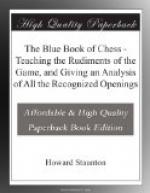[Footnote A: White in this instance had probably made up his mind to adopt the plan frequently employed by Gunsberg in the Giuoco Piano, namely, playing Q. to Q’s 2d and Castling rapidly on the Queen’s side.—Gunsberg.]
[Footnote B: ... Black’s difficulty is how to dispose of the Kt. Now Kt’s 3d in this instance, although perhaps preferable, is not a good place either, subject as it must be to an early attack from the K. R. P.—Hoffer.]
[Footnote C: If 11. B. takes Kt., Kt. to B’s 5th; and the Kt. cannot be captured on account of B. to Kt’s 4th winning the Queen.—Leeds Mercury.]
[Footnote D: ... There seems little use in this move. Either he can Castle now; if not, then it is proof positive that his defence is bad.—Gunsberg.]
[Footnote E: This premature advance is admirably taken advantage of by Steinitz.—Leeds Mercury.]
[Footnote F: ... Although this looks like a defensive move, (to make room for the Kt.) it is a subtle design which was entirely overlooked by Lasker.—Hoffer.]
[Footnote G: But here is a great mistake, which ought to lose the game. 16. P. takes Q. B. would have averted the loss of a Pawn, but at the expense of position and attack; he was outplayed by Steinitz up to this point.]
[Footnote H: From this move to the end Lasker exhibits most marvellous power of resource. With 20. Q. R. to B’s sq. he commenced one of the most ingenious attacks.]
[Footnote I: One of the moves which will make this game memorable. The object is, if P. takes P. to open up the Rook’s file by P. to R’s 5th. Allowance must of course be made for the fact that, being two Pawns behind, White has nothing to lose and everything to gain by desperate tactics.—Gunsberg.]
[Footnote J: Exhibiting consummate coolness in a “do or die” predicament.—Pollock.]
[Footnote K: 33. B. to B’s 5th is evidence with what perfect lucidity Lasker detects the weak spots, and how immediately he takes advantage of his opponent’s slightest omission or commission.—Hoffer.]
[Footnote L: ... Imprudent. The King should make for safety in the corner, via B’s 2d.—Mason.]
[Footnote M: Threatening R. to B’s 8th.—Gunsberg.]
[Footnote N: ... 41. Q. to Q’s 2d is a final blunder. 41. R to Q’s 2d should have been played, or R. to K’s 3d. The game is now over. It will be readily admitted that it is a well-earned victory which none will grudge the plucky young player.—Hoffer.




